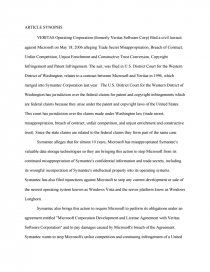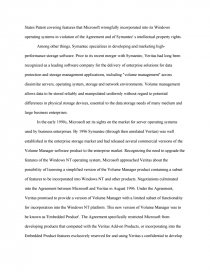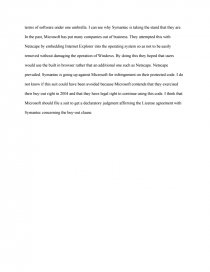Article Synopsis
Essay by 24 • March 8, 2011 • 986 Words (4 Pages) • 1,091 Views
ARTICLE SYNOPSIS
VERITAS Operating Corporation (formerly Veritas Software Corp) filed a civil lawsuit against Microsoft on May 18, 2006 alleging Trade Secret Misappropriation, Breach of Contract, Unfair Competition, Unjust Enrichment and Constructive Trust Conversion, Copyright Infringement and Patent Infringement. The suit, was filed in U.S. District Court for the Western District of Washington, relates to a contract between Microsoft and Veritas in 1996, which merged into Symantec Corporation last year. The U.S. District Court for the Western District of Washington has jurisdiction over the federal claims for patent and copyright infringements which are federal claims because they arise under the patent and copyright laws of the United States. This court has jurisdiction over the claims made under Washington law (trade secret, misappropriation, breach of contract, unfair competition, and unjust enrichment and constructive trust). Since the state claims are related to the federal claims they form part of the same case.
Symantec alleges that for almost 10 years, Microsoft has misappropriated Symantec's valuable data storage technologies so they are bringing this action to stop Microsoft from its continued misappropriation of Symantec's confidential information and trade secrets, including its wrongful incorporation of Symantec's intellectual property into its operating systems. Symantec has also filed injunctions against Microsoft to stop any current development or sale of the newest operating system known as Windows Vista and the server platform know as Windows Longhorn.
Symantec also brings this action to require Microsoft to perform its obligations under an agreement entitled "Microsoft Corporation Development and License Agreement with Veritas Software Corporation" and to pay damages caused by Microsoft's breach of the Agreement. Symantec wants to stop Microsoft's unfair competition and continuing infringement of a United States Patent covering features that Microsoft wrongfully incorporated into its Windows operating systems in violation of the Agreement and of Symantec' s intellectual property rights.
Among other things, Symantec specializes in developing and marketing high-performance storage software. Prior to its recent merger with Symantec, Veritas had long been recognized as a leading software company for the delivery of enterprise solutions for data protection and storage management applications, including "volume management" across dissimilar servers, operating system, storage and network environments. Volume management allows data to be stored reliably and manipulated uniformly without regard to potential differences in physical storage devices, essential to the data storage needs of many medium and large business enterprises.
In the early 1990s, Microsoft set its sights on the market for server operating systems used by business enterprises. By 1996 Symantec (through then unrelated Veritas) was well established in the enterprise storage market and had released several commercial versions of the Volume Manager software product to the enterprise market. Recognizing the need to upgrade the features of the Windows NT operating system, Microsoft approached Veritas about the possibility of licensing a simplified version of the Volume Manager product containing a subset of features to be incorporated into Windows NT and other products. Negotiations culminated into the Agreement between Microsoft and Veritas in August 1996. Under the Agreement, Veritas promised to provide a version of Volume Manager with a limited subset of functionality for incorporation into the Windows NT platform. This new version of Volume Manager was to be known as 'Embedded Product'. The Agreement specifically restricted Microsoft from developing products that competed with the Veritas Add-on Products, or incorporating into the Embedded Product features exclusively reserved for and using Veritas s confidential to develop replacements for the Embedded Product or otherwise compete
...
...



